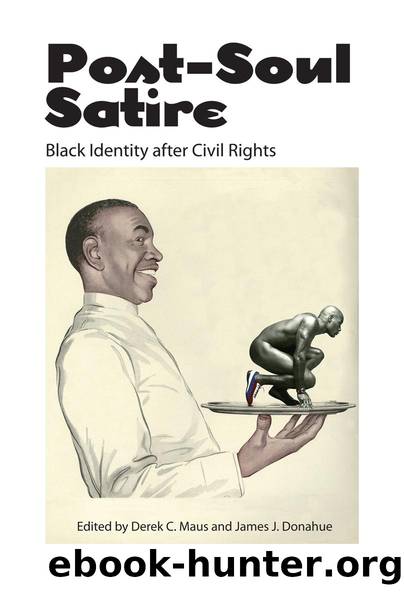Post-Soul Satire by Derek C. Maus James J. Donahue

Author:Derek C. Maus, James J. Donahue [Derek C. Maus, James J. Donahue]
Language: eng
Format: epub
ISBN: 9781617039973
Barnesnoble:
Publisher: University Press of Mississippi
Published: 2014-07-07T00:00:00+00:00
Dissimulating Blackness: The Degenerative Satires of Paul Beatty and Percival Everett
Christian Schmidt
One of the distinctive criteria for defining satire and differentiating it from such related modes as parody is that satire needs to have an extra-textual or extramural targetâa satiric âtarget that is independent of the text itselfâ (Knight 45; emphasis added). As Charles Knight acknowledges, however, the way in which satire textualizes this extra-textual target is a vexed issue. In other words, the seemingly straightforward relationship between textual representation and represented world is much more complicated than some strands of satire criticism have been willing to concede. In fact, there has been an ongoing critical discussion about whether satire is or is not a mimetic art form, that is, whether or not satires directly refer to an external reality outside the text. Dustin Griffin finds a conciliatory middle path between the two extreme positions by acknowledging that âhistorical particulars in satire always have a curious in-between status, neither wholly fact nor wholly fictionâ (123). Along similar lines, Steven Weisenburger has convincingly singled out what he calls the âdegenerative modeâ of satire, a mode that complicates the notion of mimetic referentiality of satiric literary texts. Degenerative satire is aware of the inherent limitations of diegetic representation of an external world and therefore, he says, turns inward to âreflect suspiciously on all ways of making meaning, including its ownâ (3; emphasis added). Like parody, degenerative satire has as its target âanother form of coded discourse,â and as satire, it targets the extra-textual and is âsocial in its focusâ (Hutcheon 16).
It is here that degenerative satire encounters a paradox: it acknowledges self-consciously that it cannot and will not represent anything directly, yet at the same time it is dependent on such textual representations to transmit its moral and/or ethical position on matters social and extra-textual. According to Weisenburger, this leads the degenerative satirist to â[turn] metafictionist and parodist, seeking out âintramuralâ and self-referring ways of striking at the aesthetic rules hemming us inâ (5). As I will show in my reading of three exemplary novelsâErasure (2001) and A History of the African-American People [Proposed] by Strom Thurmond. As Told to Percival Everett and James Kincaid (2004), by Percival Everett,1 and Slumberland (2008), by Paul Beattyâthe central feature of degenerative satire thus becomes the constant interplay between the spheres of the intra- and the extramural, both in terms of narrated content (such as tropes of mirrors, walls, authorial personae) and in terms of narrative presentation (for example, multilayered levels of narration, textual devices of mirroring, and a generally self-conscious and self-reflexive form of narration). Dissimulating (namely, concealing, in part or in full) blackness behind a wide array of visible and invisible walls, these three novels both parody and satirize conventional images of blackness in the African American canon.
It is only logical that degenerative satire relies heavily on parody. If we define parody as any âcultural practice which provides a relatively polemical allusive imitation of another cultural production or practiceâ (Dentith 9) or as
Download
This site does not store any files on its server. We only index and link to content provided by other sites. Please contact the content providers to delete copyright contents if any and email us, we'll remove relevant links or contents immediately.
The Power of Myth by Joseph Campbell & Bill Moyers(1015)
Half Moon Bay by Jonathan Kellerman & Jesse Kellerman(958)
Inseparable by Emma Donoghue(941)
A Social History of the Media by Peter Burke & Peter Burke(940)
The Nets of Modernism: Henry James, Virginia Woolf, James Joyce, and Sigmund Freud by Maud Ellmann(837)
The Spike by Mark Humphries;(771)
The Complete Correspondence 1928-1940 by Theodor W. Adorno & Walter Benjamin(753)
A Theory of Narrative Drawing by Simon Grennan(747)
Culture by Terry Eagleton(726)
Ideology by Eagleton Terry;(700)
Bodies from the Library 3 by Tony Medawar(683)
World Philology by(680)
Farnsworth's Classical English Rhetoric by Ward Farnsworth(676)
Game of Thrones and Philosophy by William Irwin(671)
High Albania by M. Edith Durham(660)
Adam Smith by Jonathan Conlin(651)
A Reader’s Companion to J. D. Salinger’s The Catcher in the Rye by Peter Beidler(649)
Comic Genius: Portraits of Funny People by(618)
Monkey King by Wu Cheng'en(613)
